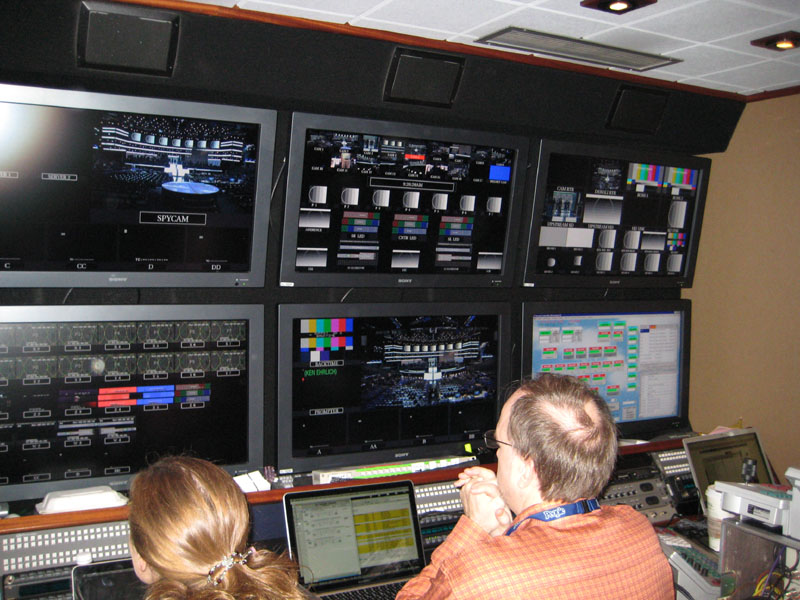Producing the 53rd Grammy Awards Concert
The Grammy Awards get their share of slings and arrows from hipsters, but as CD and more recently ticket sales continue to decline, finding ways to "eventize" the concert experience and create a recording of it that can offer continuous revenue streams going forward might be Grammy's biggest contribution yet to keeping the music business as we know it alive.
Music Mixes
Just off the door to the production office, Charlie Campbell of Music Mix Mobile (M3) monitors the point at which the A and B stages and the audio signal feeds to FOH, monitor world and the broadcast compound converge, including the mult for all 56 channels of wireless microphones used on the show and the Aphex 1788A 8-channel mic preamps that control and store input levels. He also monitors the MADI streams that are sent to the broadcast trucks via fiber-optic cabling. "This area is one of the signal intersections of the show," he says.
Out in the trucks, the workflow introduced a couple of years ago continues to be refined. As the earlier workflow improvements allowed the number of artists performing to increase, it began to tax the automation capabilities of a single console. So, in 2006, they went back to a two-truck model, but with a twist. It was an ergonometric move, one that enabled the mixers to ping-pong the mixes between them, vastly increasing their productivity.
For instance, the first rehearsal of the day on Thursday was Lady Antebellum, which mixer John Harris, in the M3 East truck, mixed during their allotted 75 minutes or so. Meanwhile, the next artist has been set up on the other side of the bifurcated stage. As soon as Lady Antebellum's rehearsal is done, Harris's counterpart Eric Schilling starts mixing the next rehearsal in the M3 East truck, enabling Harris to continue to work Lady Antebellum's previously recorded rehearsal mix in the M3 West truck, with the artists and producer present.
The rehearsal mixes are recorded to 160-channel Pro Tools HD 6 systems in the M3 East truck and ported via a MADI link to the M3 West truck, streaming both audio and video, the latter via an Avid Mojo SDI, with the machines locked using Gefen DVI and USB extenders, a system constructed by M3 engineer-in-charge Joel Singer. For the actual broadcast, the M3 East truck does all the surround music mixes, which are then fed to the Denali truck, where engineer Tom Holmes mixes them with audience ambience and production dialogue audio.

"This makes for tremendous efficiency during rehearsals and later during the actual show," says Harris. Schilling adds that the psychological boost that the performers receive is incalculable. "The confidence level is tremendous," he says. "They have a real comfort zone, knowing that we can take the time they need to feel good about the mix we're doing for them." If the Grammy Awards show is to become a kind of template for the event concert of the future, that kind of confidence for artists would be critical.
This ping-pong approach to the music mixes got a significant refinement last year: The newest M3 West truck is literally a mirror image of its sister vehicle, from their Digidesign Icon digital desks and Genelec DSP 5.1 monitoring systems (consisting of 8250A Bi-Amplified Active DSP monitors in an L-C-R array, a pair of 8240A Bi-Amplified Active DSP monitors for L-R surrounds, and 7260A Active DSP subs) right down to the acoustical treatments in the control rooms. "In the past, the trucks had similar electronics, and that was a start," says Harris. "But getting these two trucks to be literally identical makes a huge difference-you can be in either truck and everything is the same. It's huge psychological boost for us and the artists. There's so much more predictability to the sound."
Both trucks also use the Waves Audio Mercury bundle of plug-in processors, which both Harris and Schilling say adds to sonic consistency between the trucks and brings the processing up a notch. But it's not just technology the mixers are using; there's some interesting technique, as well. For instance, they now do what they refer to as "mixing defensively," a term that cropped up quite often around the trucks. Simply put, that meant taking the kick and snare out of the center channel where those transient signals were tripping home theater systems' compression chips, which could make it seem to listeners that the vocal was being overwhelmed or even missing altogether. "We created a phantom center for the kick and snare, putting them left and right," Schilling explains. "The vocal is still dead center, as is the bass. It's the transient elements that we moved out."